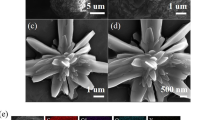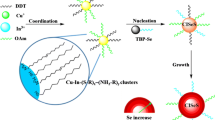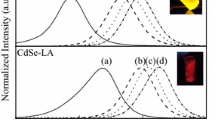Abstract
The ionic liquids containing Cd and Zn, which served as the metal-chalcogenides precursors, were synthesized and reacted with Na2S to synthesize the ionic-liquid-capped semiconductors. The products were detected by XRD and TEM. The results demonstrated that the CdS was composed of 5–6 nm monodispersed nanocrystals. At the same time, the ZnO composed of 1 μm hexagonal-disk nanostructure was prepared under the same experimental condition. The difference of the morphology and structures between Zn and Cd systems was discussed by thermodynamics and crystallography. The fluorescence of as-prepared ZnO and CdS showed the excellent photoluminescence.
Similar content being viewed by others
References
Alivisatos A P. Semiconductor clusters, nanocrystals and quantum dots. Science, 1996, 271: 933–937
Han M Y, Gao X H, Su J Z, Nie S M. Quantum-dot-tagged microbeads for multiplexed optical coding of biomolecules. Nature, 2001, 19: 631–635
Hines M A, Guyot-Sionnest P. Synthesis and characterization of strongly luminescing ZnS-capped CdSe nanocrystals. J Phys Chem, 1996, 100: 468–471
Tessler N, Medvedev V, Kazes M, Kan S H, Banin U. Efficient near-infrared polymer nanocrystal light-emitting diodes. Science, 2002, 295: 1506–1508
Steckel J S, Coe-Sullivan S, Bulovic V, Bawendi M G. 1.3 m to 1.55 m tunable electroluminescence from PbSe quantum dots embedded within an organic device. Adv Mater, 2003, 15(21): 1862–1866
Bruchez M J, Moronne M, Gin P, Alivisatos A P. Semiconductor nanocrystals as fluorescent biological labels. Science, 1998, 281: 2013–2016
Chan W C W, Nie S M. Quantum dot bioconjugates for ultrasensitive nonisotopic detection. Science, 1998, 281: 2016–2018
Murray C B, Norris D J, Bawendi M G. Synthesis and characterization of nearly monodisperse CdE (E=sulfur, selenium, tellurium) semiconductor nanocrystallites. J Am Chem Soc, 1993, 115: 8706–8715
Peng X G, Manna L, Yang W D, Wickham J, Scher E, Kadavanich A, Alivisatos A P. Shape control of CdSe nanocrystals. Nature, 2000, 404(6773): 59–61
Peng Z A, Peng X G. Formation of high-quality CdTe, CdSe and CdS nanocrystals using CdO as precursor. J Am Chem Soc, 2001, 123(1): 183–184
Li J J, Wang Y A, Guo W, Keay J C, Mishima T D, Johnson M B, Peng X G. Large-scale synthesis of nearly monodisperse CdSe/CdS core/shell nanocrystals using air-stable reagents via successive ion layer adsorption and reaction. J Am Chem Soc, 2003, 125(41): 12567–12575
Warner J H, Tilley R D. Synthesis and self-assembly of triangular and hexagonal CdS nanocrystals. Adv Mater, 2005, 17(24): 2997–3001
Cheng Y, Wang Y, Bao F, Chen D. Shape control of monodisperse CdS nanocrystals: Hexagon and pyramid. J Phys Chem B, 2006, 110: 9448–9451
Lodge T P. Materials science: A unique platform for materials design. Science, 2008, 321: 50–51
Rogers R D, Seddon K R. Chemistry: Ionic liquids-solvents of the future? Science, 2003, 302: 792–793
Davis J H, Fox P A. From curiosities to commodities: Ionic liquids begin the transition. Chem Commun, 2003, (11): 1209–1212
Wasserscheid P, Keim W. Ionic liquids-new “solutions” for transition metal catalysis. Angew Chem Int Ed, 2000, 39(21): 3772–3789
Li Y D, Liao H W, Ding Y, Fan Y, Zhang Y, Qian Y T. Solvothermal elemental direct reaction to CdE (E = S, Se, Te) semiconductor nanorod. Inorg Chem, 1999, 38: 1382–1387
Koen B. Ionic liquid crystals. Chem Rev, 2005, 105: 4148–4204
Qin Y, Song Y, Sun N J, Zhao N N, Li M X, Qi L M. Ionic liquid-assisted growth of single-crystalline dendritic gold nanostructures with a three-fold symmetry. Chem Mater, 2008, 20: 3965–3972
Itoh H, Naka K, Chujo Y. Synthesis of gold nanoparticles modified with ionic liquid based on the imidazolium cation. J Am Chem Soc, 2004, 126: 3026–3027
Biswasand K, Rao C N R. Use of ionic liquids in the synthesis of nanocrystals and nanorods of semiconducting metal chalcogenides. Chem Eur J, 2007, 13: 6123–6129
Nonoguchi Y, Nakashima T, Kawai T. Size- and temperature-dependent emission properties of zinc-blende CdTe nanocrystals in ionic liquid. J Phys Chem C, 2007, 111: 11811–11815
Zhu H G, Huang J F, Pan Z W, Dai S. Ionothermal synthesis of hierarchical ZnO nanostructures from ionic-liquid precursors. Chem Mater, 2006, 18: 4473–4477
Liu D P, Li G D, Su Y, Chen J S. Highly luminescent ZnO nanocrystals stabilized by ionic-liquid components. Angew Chem Int Ed, 2006, 45: 7370–7373
Shi E W, Zhong W Z, Hua S K, Yuan R L, Wang B G, Xia C T, Li W J. On the negative ion polyhedron coordination growth model (in Chinese). Sci China Ser E, 1998, 28: 37–45
Wang B G, Shi E W, Zhong W Z, Xia C T, Li W J, Yin Z W. Growth habits and mechanism of ZnO microcrystallites under hydrothermal conditions (in Chinese). J Chin Ceram Soc China, 1997, 25: 223–229
Hu J T. ZnO, ZnS nanomaterials preparation and properties of light-emitting (in Chinese). Dissertation for the Doctoral Degree. Hefei: University of Science and Technology University of China, 2006. 27–58
Bahnemann D W, Kormann C, Hoffmann M R. Preparation and characterization of quantum size zinc oxide: A detailed pectroscopic study. J Phys Chem, 1987, 91: 3789–3798
Schubnell M, Kamber I, Beaud P. Photochemistry at high temperatures: Potential of ZnO as a high temperature photocatalyst. Appl Phys A, 1997, 64: 109–113
Emeline A V, Ryabchuk V K, Serpone N. Spectral dependencies of the quantum yield of photochemical processes on the surface of nano-/microparticulates of wide-band-gap metal oxides. 1. Theoretical approach. J Phys Chem B, 1999, 103: 1316–1324
Xiong H M, Liu D P, Xia Y Y, Chen J S. Polyether-grafted ZnO nanoparticles with tunable and stable photoluminescence at room temperature. Chem Mater, 2005, 17: 3062–3064
Author information
Authors and Affiliations
Corresponding author
Additional information
Supported by the National Natural Science Foundation of China (Grant No. 20871041) and the Key Project of Ministry of Education (Grant No. 208086)
Rights and permissions
About this article
Cite this article
Tao, L., Xu, H., An, Y. et al. Highly luminescent ZnO and CdS nanostructures prepared by ionic liquid precursors. Sci. China Ser. B-Chem. 52, 2141–2147 (2009). https://doi.org/10.1007/s11426-009-0104-1
Received:
Accepted:
Published:
Issue Date:
DOI: https://doi.org/10.1007/s11426-009-0104-1




